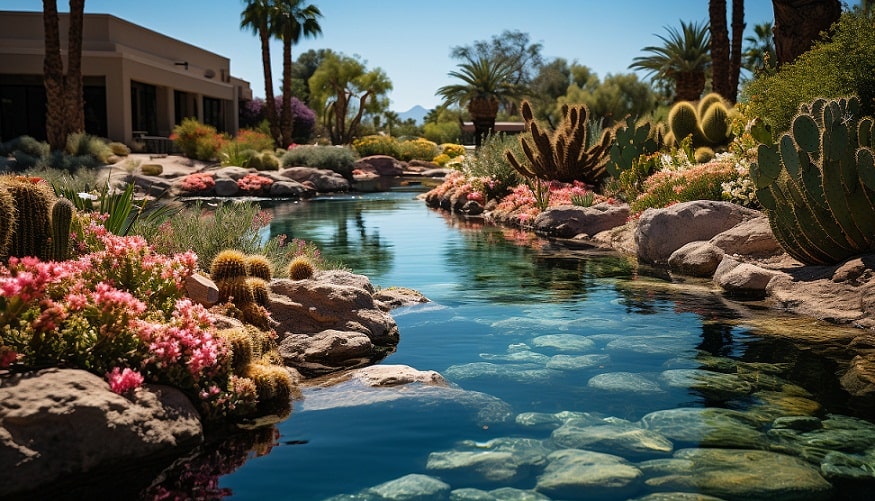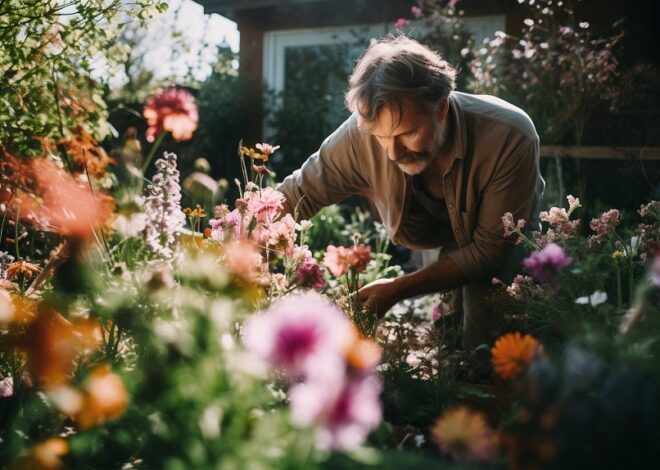
From Start to Finish: Planning and Constructing the Perfect Water Feature for Your Garden Pond Installation
Imagine stepping into your backyard and being greeted by the soothing sound of flowing water, surrounded by vibrant greenery and colorful flowers. A well-designed water feature can transform any garden into a tranquil oasis, adding beauty and serenity to your outdoor space. In this blog post, we will guide you through the process of planning and constructing the perfect water feature for your garden, from start to finish. Get ready to turn your backyard into a peaceful retreat that you’ll never want to leave!
Introduction to Water Features in Garden Pond Installation
Imagine the tranquil sound of water trickling gently in your garden, creating a serene oasis right outside your door. Water features have a magical way of transforming outdoor spaces, adding a touch of elegance and tranquility to any landscape. In this blog post, we will guide you through the process of planning and constructing the perfect water feature for your garden. Whether you dream of a peaceful pond or a captivating fountain, we’ve got you covered!
Benefits of Having a Water Feature in Your Garden
Adding a water feature to your garden can bring a sense of tranquillity and relaxation to your outdoor space. The gentle sound of flowing water can create a peaceful ambiance, perfect for unwinding after a long day or enjoying your morning coffee.
Not only does a water feature enhance the visual appeal of your garden, but it also attracts wildlife such as birds and butterflies. Watching these visitors enjoy the water adds another layer of enjoyment to your outdoor environment.
Water features can also help mask noise from nearby streets or neighbors, providing you with a more serene atmosphere in which to spend time outdoors. Additionally, the reflective properties of water can make your garden feel larger and more vibrant.
Whether you choose a pondless waterfall, traditional pond, or fountain, incorporating a water feature into your garden is sure to elevate its beauty and charm.
Planning and Designing Your Water Feature
When planning and designing a water feature for your garden, the first step is to choose the right location. Consider factors like sunlight exposure, proximity to utilities, and visibility from key areas of your outdoor space.
Next, think about the size and shape of your water feature. Will it be a small fountain or a large pond? The dimensions should complement your garden’s overall layout while also leaving enough room for surrounding plants and pathways.
Budgeting is crucial in this phase as well. Determine how much you’re willing to spend on materials, labor, and maintenance costs. Research different options such as pre-formed ponds, natural stone fountains, or DIY waterfall kits to find what aligns with your financial plan.
Lastly, selecting the appropriate materials is essential. From durable liners to decorative rocks and aquatic plants, each component plays a role in creating a harmonious water feature that enhances the beauty of your garden pond installation.
Choosing the Right Location
When it comes to choosing the right location for your garden pond installation, there are a few key factors to consider. First and foremost, think about the natural flow of your garden – you want the water feature to complement the overall landscape seamlessly.
Consider placing your pond in an area that receives a good balance of sunlight and shade throughout the day. This will help maintain a healthy ecosystem within the pond, supporting plant and fish life.
Avoid areas with overhanging trees or shrubs that could drop leaves or debris into the water, as this can cause maintenance issues down the line. Additionally, be mindful of underground utilities and ensure you won’t be digging near any pipes or cables.
Lastly, think about visibility from different areas of your outdoor space. You’ll want to position your pond where it can be enjoyed from various vantage points like a patio or seating area. By carefully selecting the right spot for your water feature, you can create a tranquil oasis in your own backyard.
Size and Shape Considerations
When planning and designing your water feature, size and shape considerations play a crucial role in achieving the desired look for your garden.
The size of your water feature should complement the overall scale of your garden space. A small pond may get lost in a large yard, while an oversized fountain could overwhelm a cozy patio area.
Consider the shape of your water feature as well. Rectangular ponds can provide a formal and structured feel, perfect for classic gardens. On the other hand, free-form shapes like naturalistic ponds or meandering streams offer a more organic and relaxed vibe.
Take into account how different sizes and shapes will impact the flow of your garden design. Whether you opt for something sleek and symmetrical or more whimsical and irregular, ensure that it harmonizes with the existing elements in your outdoor space.
Budgeting and Materials
When planning your garden pond installation, setting a budget is crucial. Start by determining how much you are willing to invest in your water feature project. Consider the costs of materials such as liners, pumps, filters, and rocks. Research different options to find the best quality within your budget.
Choose materials that will withstand outdoor elements and require minimal maintenance. Opt for durable pond liners that won’t easily tear or puncture. Select energy-efficient pumps to keep operating costs down in the long run. Incorporate natural stones or pebbles for a visually appealing finish.
To save on expenses, consider DIY options for certain aspects of the construction process. Look for local suppliers or online deals to get competitive prices on materials. Remember that investing in high-quality components upfront can lead to fewer repairs and replacements down the line.
By carefully budgeting and selecting suitable materials, you can create a stunning water feature that enhances your garden’s beauty without breaking the bank.
Types of Water Features for Different Garden Styles
When it comes to enhancing your garden with a water feature, there are various options to suit different styles and preferences. For those looking for a low-maintenance option, pondless waterfalls provide the soothing sounds of running water without the need for a pond. They’re perfect for modern or minimalist gardens.
Traditional ponds, on the other hand, add a touch of tranquility and charm to classic or rustic garden settings. With the right combination of aquatic plants and fish, they can create a vibrant ecosystem in your backyard oasis.
Fountains are versatile features that can complement any garden style, from formal to tropical. Their elegant designs and variety of sizes make them suitable for both small urban gardens and sprawling estates. Plus, fountains offer the benefits of masking unwanted noise and attracting birds with their refreshing spray.
Whatever your garden style may be, there’s a water feature out there waiting to transform your outdoor space into a peaceful retreat.
Pondless Waterfalls
Imagine the soothing sound of water cascading down rocks, adding a sense of tranquility to your garden. Pondless waterfalls offer all the beauty and serenity of a traditional pond without the maintenance or safety concerns. These features are perfect for smaller spaces or families with young children.
Pondless waterfalls consist of a reservoir buried beneath gravel or decorative stones, where the water is collected and recirculated through a pump. This setup eliminates the need for standing water, making it safer and easier to maintain.
The design options for pondless waterfalls are endless – from natural rock formations to sleek modern styles. You can customize the size, shape, and flow of your waterfall to fit seamlessly into your garden landscape.
Not only do pondless waterfalls enhance visual appeal, but they also attract wildlife like birds and butterflies. By incorporating this feature into your garden design, you create a peaceful retreat right outside your door.
Traditional Ponds
Traditional ponds are a timeless addition to any garden, bringing a sense of tranquility and elegance. These classic water features typically consist of an excavated area lined with a durable material like PVC or rubber to hold water. Traditional ponds can vary in size and depth, depending on your space and design preferences.
To create a traditional pond, you will need to carefully plan the location, ensuring it receives adequate sunlight and is away from overhanging trees that could drop debris into the water. Consider incorporating aquatic plants like lilies or lotus for added beauty and natural filtration.
A traditional pond can attract wildlife such as birds, butterflies, and even frogs, enhancing the biodiversity of your garden. The soothing sound of running water can also provide a calming atmosphere for relaxation or meditation in your outdoor space.
When designing your traditional pond, think about adding elements like rocks or statuary around the edges to blend seamlessly with your garden’s aesthetic. With proper maintenance and care, a traditional pond can become the focal point of your landscape for years to come.
Fountains
When it comes to adding a touch of elegance and sophistication to your garden, fountains are a timeless choice. The gentle sound of water flowing can create a soothing atmosphere that enhances the overall ambiance of your outdoor space.
Fountains come in various styles and sizes, making them versatile for different garden designs. Whether you prefer a classic tiered fountain or a modern sculpture-style fountain, there is something to suit every taste.
Incorporating a fountain into your garden design can also attract wildlife such as birds and butterflies, adding another layer of charm to your outdoor sanctuary. Plus, the movement of water in fountains can help mask noise pollution from nearby streets or neighbors.
Maintenance for fountains is relatively easy compared to other water features like ponds. Regular cleaning and occasional pump maintenance will keep your fountain running smoothly for years to come.
Step-by-Step Construction Process
When it comes to constructing a water feature for your garden, the step-by-step process is crucial in ensuring a successful installation.
Firstly, start by preparing the area where you want to place your water feature. Clear any debris and ensure that the ground is level to avoid any issues later on.
Next, begin building the base and foundation of your water feature. This may involve digging out space for a pond or laying down gravel for a fountain. Make sure that everything is sturdy and secure.
After establishing the base, proceed with installing the necessary components such as pumps, filters, and pipes. These elements are essential for keeping your water feature running smoothly.
Finally, add finishing touches like rocks, plants, or lighting to enhance the overall aesthetic appeal of your garden pond installation. Take your time to perfect every detail for a truly stunning end result!
Preparing the Area
Before you begin the exciting journey of constructing your garden pond, it’s crucial to prepare the area properly. Start by clearing any debris, rocks, or roots that may obstruct the site. This will ensure a smooth and level surface for your water feature.
Next, mark out the desired shape and size of your pond using ropes or spray paint. Take into consideration any surrounding plants or structures that could complement the design. Remember that proper planning at this stage will save you time and effort later on.
Once you have outlined the pond’s dimensions, start excavating the area to achieve the desired depth. Remove soil gradually while checking for levelness frequently to avoid uneven surfaces in your pond base.
As you dig deeper, consider installing an underlayment layer to protect your pond liner from sharp objects underground. This extra step can prolong the life of your water feature and prevent costly repairs down the line.
Lastly, ensure proper drainage around the perimeter of your pond to prevent water runoff issues during heavy rainfall. By taking these preparatory steps seriously, you’re setting yourself up for a successful garden pond installation project with minimal setbacks in sight!
Building the Base and
Building the base and foundation of your water feature is a crucial step in ensuring its stability and longevity. This stage involves carefully laying down the materials, whether it’s rocks for a pondless waterfall or bricks for a fountain, to create a solid structure that will support the water feature.
Once the base is set, it’s time to add the final touches like plants, lighting, and decorative elements that will enhance the overall aesthetics of your garden pond installation. With everything in place, sit back and enjoy the peaceful ambiance that your new water feature brings to your outdoor space.
Remember, creating a water feature for your garden is not just about adding visual appeal – it’s also about fostering a sense of tranquility and connection with nature. So go ahead, start planning and constructing your perfect water feature today to transform your garden into an oasis of relaxation and beauty.


